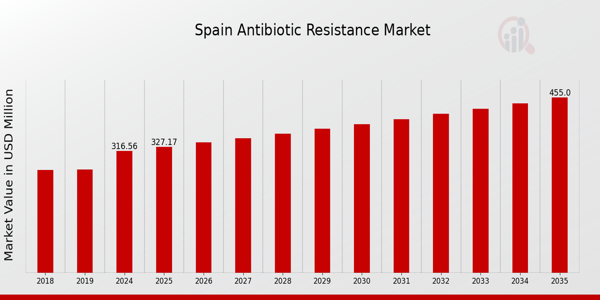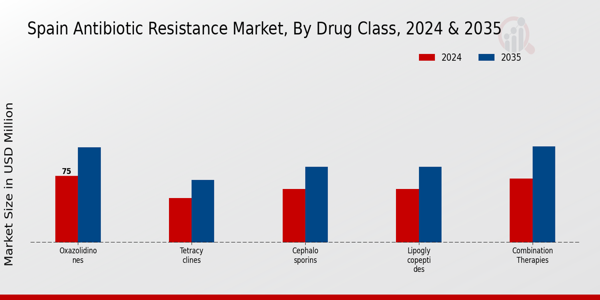Spain Antibiotic Resistance Market Overview
As per MRFR analysis, the Spain Antibiotic Resistance Market Size was estimated at 300.72 (USD Million) in 2023. The Spain Antibiotic Resistance Market Industry is expected to grow from 316.56(USD Million) in 2024 to 455 (USD Million) by 2035. The Spain Antibiotic Resistance Market CAGR (growth rate) is expected to be around 3.353% during the forecast period (2025 - 2035)
Key Spain Antibiotic Resistance Market Trends Highlighted
In Spain, the increasing prevalence of antibiotic resistance presents a significant challenge to public health, driving a strong focus on developing new antibiotics and alternative therapies. This issue is propelled by factors such as inappropriate antibiotic use in both humans and animals, leading to a rise in complex infections that are harder to treat. Spanish health authorities have acknowledged this problem and are actively promoting initiatives to raise awareness and ensure better antibiotic stewardship in both hospitals and outpatient settings.
There is an emphasis on education for healthcare professionals and patients alike regarding the dangers of overusing these medications.There is ample opportunity related to the research and development of systematic therapeutics and rapid diagnostic methods for pathogen resistance.
In addition, the Spanish government promotes diverse funding activities and innovation development research programs. Furthermore, there is growing collaboration between public health, academic, and industry stakeholders. Recently, there seems to be an increase in the level of restriction on the prescribing of antibiotics, as well as the supervision of their use in agriculture. The Spanish Agency of Medicines and Medical Devices still sponsors the policies that focus on fostering responsible antibiotic use, as well as efforts against resistance.
Overall, the Spain Antibiotic Resistance Market is witnessing a dynamic environment driven by a collective effort to address this rising threat through innovative solutions and improved practices.

Source: Primary Research, Secondary Research, Market Research Future Database, and Analyst Review
Spain Antibiotic Resistance Market Drivers
Rising Incidence of Antibiotic-Resistant Infections
In Spain, the increase in antibiotic-resistant infections has become a significant public health concern. Data from the Spanish Society of Infectious Diseases and Clinical Microbiology indicates that antibiotic resistance rates for common pathogens like Escherichia coli and Staphylococcus aureus have increased by over 30% in the last decade.
This growing prevalence of resistant infections drives demand for new antibiotics and innovative treatment options, thus fostering growth in the Spain Antibiotic Resistance Market Industry.The Spanish healthcare system has recognized this issue and is implementing action plans to combat antibiotic resistance, which further emphasizes the urgent need for effective solutions.
Government Initiatives and Regulations
The Spanish government has been proactive in combating antibiotic resistance through various initiatives. The Spanish Ministry of Health launched a National Plan on Antimicrobial Resistance (PRAN) in 2014, which aims to reduce antibiotic use in both human and animal health.
Since the inception of this program, there has been a reported 12% decrease in antibiotic prescriptions in the community, according to recent government statistics. This regulatory environment is crucial for shaping the Spain Antibiotic Resistance Market Industry, as it promotes Research and Development of new antibiotics and sets strict guidelines for existing antibiotic usage.
Increased Awareness and Education
Public and healthcare professional awareness regarding antibiotic resistance continues to grow in Spain. Campaigns organized by various health organizations, including the WHO, have increased awareness among medical practitioners and the general public, leading to better antibiotic stewardship practices.
The Spanish newspaper El Pais reported a significant shift, noting that 73% of Spaniards are now aware of the risks associated with antibiotic misuse, compared to just 40% five years ago.This heightened level of awareness is expected to positively influence the Spain Antibiotic Resistance Market Industry by encouraging responsible prescribing and promoting the development of alternative therapies.
Spain Antibiotic Resistance Market Segment Insights
Antibiotic Resistance Market Drug Class Insights
The Spain Antibiotic Resistance Market showcases a diversified landscape within the Drug Class segment, reflecting the growing concern over antibiotic resistance in the healthcare system. As the country faces increasing rates of antibiotic-resistant infections, the emphasis on specific drug classes like Oxazolidinones and Lipoglycopeptides has gained momentum due to their efficacy against Gram-positive bacterial infections. Oxazolidinones, for instance, are critical in addressing resistant strains of Staphylococcus aureus, pushing their relevance in treatment protocols. Similarly, Lipoglycopeptides play an essential role in combating deep-seated infections, particularly in hospital settings, thus showcasing their importance in both the outpatient and inpatient realms.
On the other hand, Tetracyclines continue to be valued due to their broad-spectrum activity and cost-effectiveness, making them a preferred choice in various clinical situations in Spain. Their versatility in treating a wide range of infections has solidified their position in the antibiotic arsenal. Cephalosporins are pivotal as they represent a significant class that bridges the gap between older and newer-generation antibiotics, providing healthcare practitioners with treatment options against a multitude of infections experienced in both community and healthcare-associated settings.
Meanwhile, Combination Therapies are emerging as a strategic response to tackle resistance challenges, enabling the synergistic effect of multiple antibiotics, which enhances bacterial eradication and minimizes resistance development.
The growing emphasis on these drug classes reflects the commitment of the Spanish healthcare system towards innovative treatment solutions in the era of antibiotic resistance, ensuring that healthcare professionals are equipped with effective tools to manage and defeat resistant infections. In the face of these challenges, understanding the dynamics and contributions of these antibiotic classes is crucial for future Research and Development endeavors aimed at improving patient outcomes and addressing public health concerns associated with antibiotic resistance.
The interplay between these drug classes and their respective roles in treatment regimens signifies a nuanced understanding required to navigate the complexities of antimicrobial resistance effectively within the Spanish healthcare system. Thus, the ongoing developments and research in these areas are expected to significantly influence the overall Antibiotic Resistance Market dynamics in Spain, reflecting a collaborative approach among healthcare providers, researchers, and policymakers to tackle this pressing global health issue.

Source: Primary Research, Secondary Research, Market Research Future Database, and Analyst Review
Antibiotic Resistance Market Disease Insights
The Spain Antibiotic Resistance Market in the Disease segment reflects a critical area of concern within healthcare, as rising antibiotic resistance poses significant challenges. Notably, Complicated Urinary Tract Infections are prevalent due to increased hospital admissions, emphasizing the need for effective treatment strategies. Blood Stream Infections remain a major cause of morbidity, necessitating urgent attention given their association with high mortality rates. Additionally, Complicated Intra-Abdominal Infections are a significant focus in surgical settings, driving the demand for novel therapeutic solutions.
Clostridium Difficile Infections have emerged as a serious public health issue, often linked to antibiotic misuse, highlighting an urgent requirement for enhanced antibiotic stewardship programs in Spain. Acute Bacterial Skin and Skin Structure Infections demonstrate a rising trend, fueled by increased incidence and the prevalence of resistant bacterial strains among the population.
The ongoing efforts to combat these infections underscore the importance of Research and Development initiatives aimed at discovering alternative treatment options and reducing the overall burden of antibiotic resistance across Spain.Through a comprehensive understanding of these disease dynamics, stakeholders can better address the public health implications of antibiotic resistance.
Antibiotic Resistance Market Pathogen Insights
The Pathogen segment of the Spain Antibiotic Resistance Market presents a complex landscape driven by the increasing prevalence of antibiotic-resistant infections. Dominating the landscape are pathogens such as Staphylococcus Aureus and Streptococcus Pneumoniae, which are known for their significant impact on public health, often resulting in severe illness and hospitalizations. Acinetobacter, another critical pathogen, is notorious for its resistance to multiple drugs, making treatment options scarce and reinforcing the urgency for new antibiotic development.Enterococcus has garnered attention due to its ability to thrive in various environments, also contributing to its resistance patterns.
Additionally, Hemophilus Influenzae continues to be a concern, particularly in pediatric populations, emphasizing the need for vigilant antibiotic stewardship and ongoing Research and Development efforts. As Spain focuses on improving healthcare outcomes and addressing antibiotic resistance, understanding the dynamics of these pathogens becomes essential for enhancing treatment protocols and public health initiatives.The growing awareness of the implications of these pathogens drives interest among healthcare providers and policymakers to develop effective strategies that mitigate the risks associated with antibiotic resistance, ultimately shaping the Spain Antibiotic Resistance Market landscape.
Antibiotic Resistance Market End User Insights
The Spain Antibiotic Resistance Market is notably influenced by the End User segment, which includes Hospitals and Clinics as well as Research Organizations. Hospitals and Clinics play a critical role in managing and mitigating antibiotic resistance through responsible prescribing practices while also serving as primary treatment centers for infections. As a leading healthcare provider in Spain, this sector is vital for improving patient outcomes and reducing the burden of antibiotic resistance. Research Organizations, on the other hand, focus on studying antibiotic-resistant pathogens and developing innovative solutions to combat this growing threat.
Given the rising incidence of resistant infections, the research community’s efforts are significant in developing new therapeutic options and strategies. Together, these segments represent a collective effort to tackle antibiotic resistance, highlighting the importance of collaboration between clinical practice and research to ensure public health in Spain. Considering that healthcare infrastructure continues to evolve, the emphasis on both treatment facilities and research initiatives solidifies the framework for addressing antibiotic resistance effectively.
Spain Antibiotic Resistance Market Key Players and Competitive Insights
The Spain Antibiotic Resistance Market is characterized by an increasing emphasis on innovative solutions to combat the spread of antibiotic-resistant infections. As healthcare systems evolve in response to rising resistance levels, companies operating in this sector are focusing on developing advanced antibiotic therapies and novel treatment modalities. The competitive landscape includes a mix of established pharmaceutical giants and emerging players that offer targeted therapies, diagnostics, and stewardship programs aimed at preserving the efficacy of existing antibiotics while introducing new options.
The pressing public health challenge of antibiotic resistance necessitates collaboration between stakeholders, including researchers, healthcare providers, and the pharmaceutical industry, creating a dynamic and multifaceted market environment. Market players are distinguished by their ability to innovate in drug development, navigate regulatory landscapes, and respond to the changing demands of healthcare providers and patients.Eli Lilly has established a significant presence in the Spain Antibiotic Resistance Market, primarily through its research and development initiatives that focus on combating resistant bacterial infections.
The company's strengths lie in its commitment to innovation and its robust pipeline of antibiotic products that are designed to address unmet medical needs. Eli Lilly has prioritized the advancement of therapies that not only enhance treatment options but also align with global health strategies aimed at curbing resistance.
The company's collaboration with various healthcare institutions in Spain has enabled it to gain insights into local resistance patterns, further informing its research and development efforts. Additionally, Eli Lilly’s strong brand reputation and established distribution channels within the Spanish healthcare system enhance its competitive positioning in the market, allowing for swift adaptation to emerging challenges related to antibiotic resistance.Pfizer holds a prominent position in the Spain Antibiotic Resistance Market, leveraging its extensive expertise in pharmaceuticals to develop a comprehensive portfolio of antibiotic products and solutions.
The company is known for its key offerings that include both novel antibiotics and advanced formulations designed to combat drug-resistant organisms. Pfizer's market presence is bolstered by strategic partnerships and collaborations with local health authorities and research institutions, which facilitate access to valuable data on antibiotic resistance trends. The company has also entered into several mergers and acquisitions that have expanded its capabilities in microbial resistance research and development. Pfizer’s strengths include its capability for rapid clinical development, a strong focus on patient-centric solutions, and a dedication to supporting antibiotic stewardship programs in Spain.
These factors collectively reinforce Pfizer's competitive edge, positioning it as a leader in addressing the critical issue of antibiotic resistance in the region.
Key Companies in the Spain Antibiotic Resistance Market Include
Spain Antibiotic Resistance Market Industry Developments
The Spain Antibiotic Resistance Market has witnessed significant developments in recent months. In October 2023, Eli Lilly received acknowledgment from a Spanish government initiative for its extensive Research and Development efforts focusing on novel antibiotics to combat resistant strains. Additionally, Pfizer recently introduced a new vaccine aimed at reducing the incidence of antibiotic-resistance-related infections, further showcasing its commitment to improving public health in Spain.
Teva has been involved in discussions with regulatory authorities regarding the optimization of antibiotic access in hospitals, emphasizing the need for effective strategies to reduce the impact of antibiotic resistance. In a noteworthy shift, AstraZeneca announced the acquisition of a smaller biotech firm in Barcelona focused on antibiotic therapies in September 2023, which bolsters its portfolio in the antibiotic space. Furthermore, the Spanish health ministry reported a growing concern over antibiotic resistance levels, indicating the urgency for pharmaceutical companies like Merck and GSK to innovate.
The collective efforts of these companies, along with the government's renewed focus on combating antibiotic resistance, highlight the ongoing challenges and opportunities within the Spanish market, positioning it for potential growth and advancement in the coming years.
Spain Antibiotic Resistance Market Segmentation Insights
-
Antibiotic Resistance Market Drug Class Outlook
-
Antibiotic Resistance Market Disease Outlook
- Complicated Urinary Tract Infection
- Complicated Intra-Abdominal Infections
- Clostridium Difficile Infections
- Skin Structure Infections
-
Antibiotic Resistance Market Pathogen Outlook
-
Antibiotic Resistance Market End User Outlook
| Report Attribute/Metric Source: |
Details |
| MARKET SIZE 2023 |
300.72(USD Million) |
| MARKET SIZE 2024 |
316.56(USD Million) |
| MARKET SIZE 2035 |
455.0(USD Million) |
| COMPOUND ANNUAL GROWTH RATE (CAGR) |
3.353% (2025 - 2035) |
| REPORT COVERAGE |
Revenue Forecast, Competitive Landscape, Growth Factors, and Trends |
| BASE YEAR |
2024 |
| MARKET FORECAST PERIOD |
2025 - 2035 |
| HISTORICAL DATA |
2019 - 2024 |
| MARKET FORECAST UNITS |
USD Million |
| KEY COMPANIES PROFILED |
Eli Lilly, Pfizer, Teva, Merck, AstraZeneca, Roche, GSK, Takeda, BristolMyers Squibb, Bayer, Johnson & Johnson, AbbVie, Sanofi, Novartis |
| SEGMENTS COVERED |
Drug Class, Disease, Pathogen, End User |
| KEY MARKET OPPORTUNITIES |
Increasing demand for rapid diagnostics, Growth in antibiotic stewardship programs, Rise in public awareness campaigns, Emerging biotech innovations, Expansion of telemedicine for consultations |
| KEY MARKET DYNAMICS |
rising infection rates, increasing healthcare costs, regulatory initiatives, growing public awareness, antibiotic stewardship programs |
| COUNTRIES COVERED |
Spain |
Frequently Asked Questions (FAQ):
The Spain Antibiotic Resistance Market is expected to be valued at 316.56 million USD in 2024.
By 2035, the Spain Antibiotic Resistance Market is projected to reach a value of 455.0 million USD.
The expected CAGR for the Spain Antibiotic Resistance Market from 2025 to 2035 is 3.353%.
Major players in the Spain Antibiotic Resistance Market include Eli Lilly, Pfizer, Merck, and AstraZeneca among others.
The market value of Oxazolidinones in 2024 is estimated to be 75.0 million USD.
The market size of Combination Therapies is projected to be 108.0 million USD by 2035.
The Cephalosporins segment is expected to grow from 60.0 million USD in 2024 to 85.0 million USD by 2035.
Opportunities in the market stem from rising antibiotic resistance and increasing demand for novel therapies.
Challenges in the market include regulatory hurdles and the need for compliance in antibiotic usage.
The current global scenario may lead to heightened awareness and urgency to tackle antibiotic resistance effectively.
















